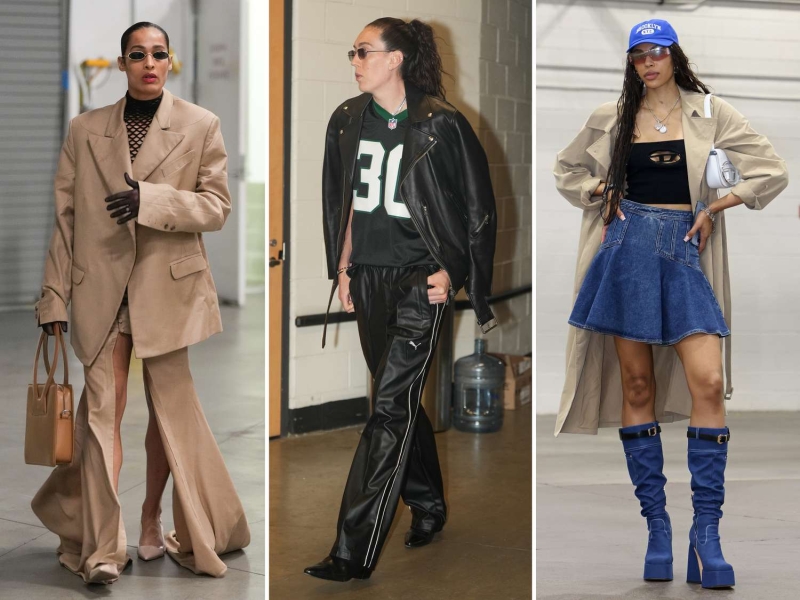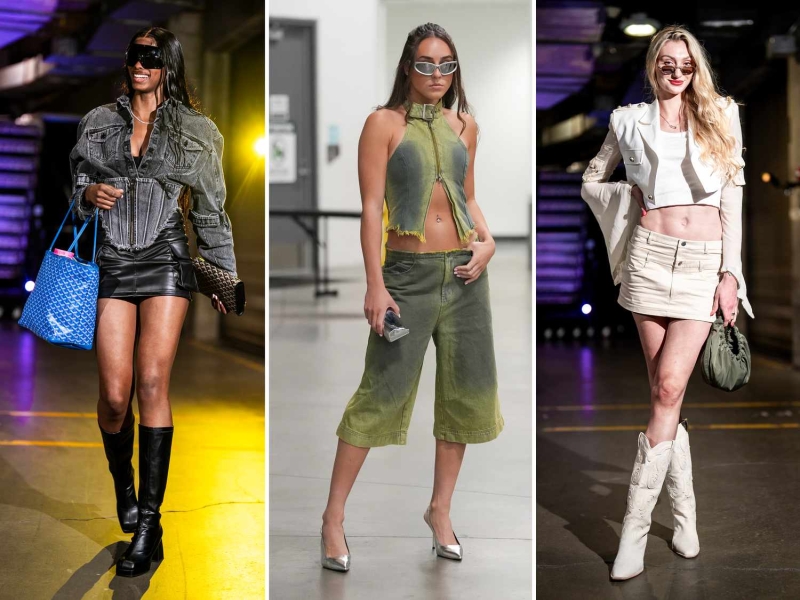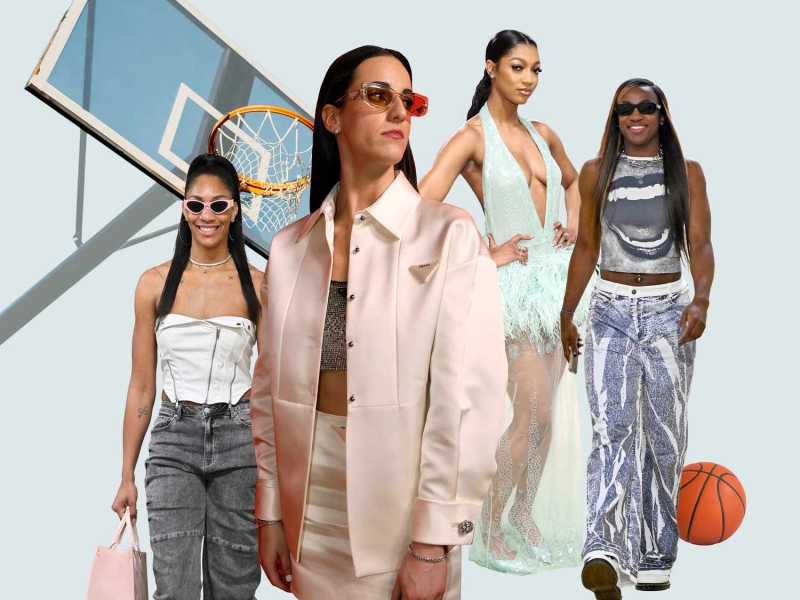There are more eyes than ever on women's basketball, thanks in part to high-fashion tunnel walks. But they're more than just fashion shows; they're an outlet for attracting attention—and money.
One of the year’s biggest fashion moments so far didn’t happen on any runway or red carpet, but rather at the WNBA Draft. On April 15, league hopeful and NCAA finalist Caitlin Clark took the stage to accept the No. 1 draft pick from the Indiana Fever in a head-to-toe Prada outfit—satin pink skirt suit and shimmery cropped top, rimless sunglasses, and a mini Prada Galleria handbag—the first custom look ever created for a WNBA draftee.
It was the kind of fashion flex reserved for A-list stars, not a recent college graduate. Granted, the grad in question had just played in a closely-followed NCAA final (her Iowa Hawkeyes against the University of South Carolina) that was viewed by a record 24 million people. But the sartorial move was seismic, cementing a new era of women’s basketball, with fashion functioning as a power tool. “Fashion is the vehicle,” says Velissa Vaughn, a publicist and former Division 1 basketball player who runs the Instagram account @wnbatunnel, “so it’s about where they are taking it.”
To the bank, hopefully. WNBA players are fast becoming tunnel style stars, a phenomenon already prevalent in other leagues, like the NBA and NFL, in which photographers document the fashion-forward looks athletes wear into a game. While the high-fashion tunnel walk is not new to the WNBA—perhaps you’ve seen the singular style of Sue Bird, Tina Charles, or Nneke Ogwumike?—players this season seem to be embracing fashion en masse. Names like Clark, Chicago Sky’s Angel Reese, Las Vegas Aces’ A’ja Wilson, Seattle Storm’s Nika Mühl, New York Liberty’s Breanna Stewart, and Rickea Jackson and Cameron Brink of the Los Angeles Sparks are entering arenas dressed like they’re coming from the catwalk: denim skirts from Diesel, Gucci tailored suits, Luar and Chanel handbags, futuristic wraparound sunglasses, knee-high cowboy boots. Et cetera. For women players, who are severely underpaid and undervalued both within their league and in the sports world at large, flexing their fashion muscle is about much more than just playing dress up; it’s about drawing attention that translates into more eyeballs on the league and bigger paychecks for athletes.
“It doesn't necessarily matter how you can get people to start watching,” says Christopher Ruff, who documents WNBA outfits under the handle @wnbaleaguefits. “It's just about getting them to do it.”

Like most women’s sports, the WNBA has a gender pay gap problem, one that forces players to rely on supplemental income—whether from endorsements or overseas off-season contracts—to make a living. While the average salary in the NBA is $10 million (with a minimum salary of $1.12 million), most WNBA players make less than $150,000 annually, according to Statista.
The issue stirred discourse earlier this year when it was revealed that Clark’s entry-level salary would be $76,000—about 600 percent less than the average NBA player. It’s a stark contrast that’s been widely justified by the league’s lower revenue, attendance, and viewership. Sports economist David Berri explains that argument is not valid. The collective bargaining agreement for NBA players guarantees them a 50-percent cut of the organization’s basketball-related income; the WNBA’s agreement has no such language. Instead, female players are guaranteed a specific number, so that, as league revenues go up, their percentage would actually decrease. What's more, the stereotype that women don’t watch sports has no evidence, Berri adds, pointing to public polling that reveals nearly half of American women consider themselves sports fans.
With fashion, WNBA players are working to circumvent the current system by transforming themselves into sartorial mavens, garnering attention, and hopefully, dollars from the fashion industry. Reese, who joined the league this season after winning the NCAA championship with USC, announced she was participating in the WNBA draft in the pages of Vogue with a full editorial spread and, later, was invited to the Met Gala, where she wore a custom aqua 16 Arlington gown that featured a plunging neckline, sheer skirt, and feathered peplum. For her first game against the Connecticut Sun on May 15, Clark walked into Gainbridge Fieldhouse in an all-black look that included a pair of Tibi jeans and Tiffany & Co. x Nike sneakers, put together by her stylist Adri Zgirdea.
Clark isn't the only player hiring someone to help her assemble her pre-game ensemble. Los Angeles-based stylist Amadi Brooks, a former basketball player, works with a range of players, including Wilson, Sydney Colson, and Jackie Young. “I noticed the gap in women's sports and the fashion industry and I just wanted to be a part of changing that over time,” Brooks says of her foray into styling WNBA players. “I would love to see more investment put behind it now that they do see there's a return of investment on it.”

Vaughn, who launched her Instagram account earlier this year and has already gained more than 20,000 followers, started her handle with the pay gap in mind. “Some of these girls are making $70,000 [annually] here,” she recalls telling herself. "If they play this smart, they can get $70,000 a quarter.” She has noticed that, although tunnel fashion has slowly been growing for years inside the WNBA, there’s been an uptick in players increasing their fashion game of late.
A few months ago, Vaughn had a set of five to 10 players that she’d always cover, but that roster has now expanded to almost every team in the league. Ruff also confirms that his account, which has documented WNBA fashion since 2021, has received more attention recently because of this new class of sartorially-minded players. “This is a vehicle for them to hopefully create brand deals outside of Gatorade or Nike, because even that is going to be limited to who can even garner those types of deals,” says Vaughn.
Players are already cashing in. In May, Skims tapped WNBA stars Cameron Brink, Candace Parker, Dijonai Carrington, Kelsey Plum, and Skylar Diggins-Smith for its "Fits Everybody campaign," which marked the beginning of the shapewear brand's official partnership with the WNBA. The e-commerce platform Revolve has also partnered with players like Brink and Reese as ambassadors. Earlier this month, New Balance announced its league partnership with a campaign starring Brink.
While it’s usually major stars that are tapped to work with big brands across all categories, Berri says that this class is ushering in change that will trickle these benefits to more players. "Going forward, I think a lot of women who are in college basketball can expect that as they transition in their professional career, they're gonna have a lot more endorsements,” he says. “They're going to have these opportunities that were not available in the past." Fingers crossed it's more than just a passing fad.

